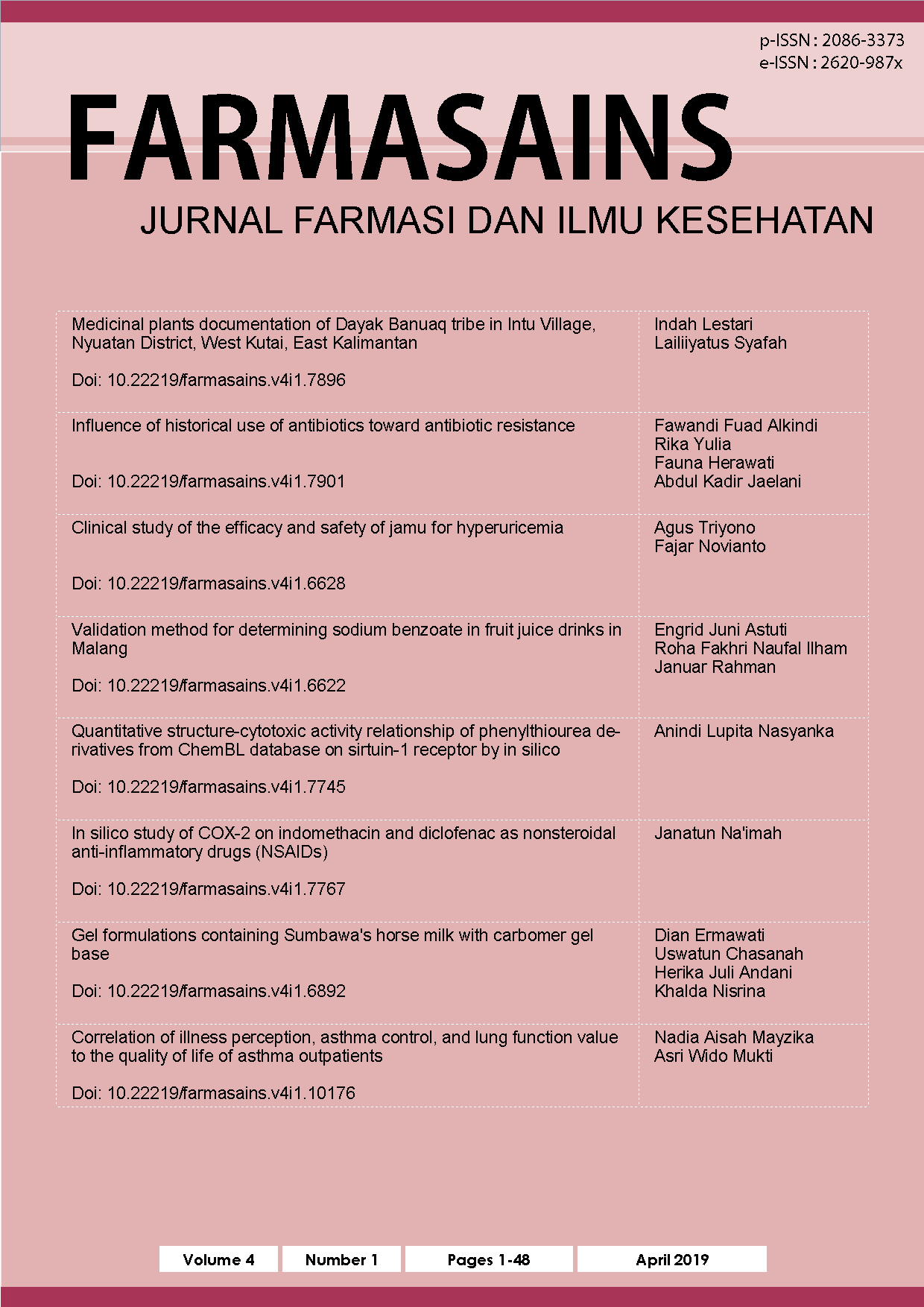Influence of historical use of antibiotics toward antibiotic resistance
DOI:
https://doi.org/10.22219/farmasains.v4i1.7901Keywords:
Resistance, Antimicrobial, Infection, Prior antibiotic, BangilAbstract
A WHO’s Global Surveillance of Antibiotic Resistance showed there is an increase of antimicrobial resistance in Asia between 2013 until 2014. Many studies showed that there is a correlation between prior antibiotic use with antimicrobial resistance case. The primary objective of this study is to analyze the relationship between prior antibiotic use with antimicrobial resistance. İt was a retrospective and descriptive study conducted at Bangil Regional General Hospital. The data collected from the medical record and microbiological test from the patient at the internal ward. Chi-square analysis used for the statistic. This study showed that prior antibiotic use increased 0,399 bigger for antimicrobial resistance rate (p=0,001).
Downloads
References
Bolon, M. K. (2011). The newer fluoroquinolones. The Medical clinics of North America, 95(4), 793-817.
Chung, A., Perera, R., Brueggemann, A. B., Elamin, A. E., Harnden, A., Mayon-White, R., ... & Mant, D. (2007). Effect of antibiotic prescribing on antibiotic resistance in individual children in primary care: prospective cohort study. BMJ, 335(7617), 429.
Ferrero, J. L., Bopp, B. A., Marsh, K. C., Quigley, S. C., Johnson, M. J., Anderson, D. J., ... & Cavanaugh, J. H. (1990). Metabolism and disposition of clarithromycin in man. Drug Metabolism and Disposition, 18(4), 441-446.
Foulds, G., Shepard, R. M., & Johnson, R. B. (1990). The pharmacokinetics of azithromycin in human serum and tissues. Journal of Antimicrobial Chemotherapy, 25(suppl_A), 73-82.
Hillier, S., Roberts, Z., Dunstan, F., Butler, C., Howard, A., & Palmer, S. (2007). Prior antibiotics and risk of antibiotic-resistant community-acquired urinary tract infection: a case–control study. Journal of antimicrobial chemotherapy, 60(1), 92-99.
Humbert, G., Spyker, D. A., Fillastre, J. P., & Leroy, A. (1979). Pharmacokinetics of amoxicillin: dosage nomogram for patients with impaired renal function. Antimicrobial agents and chemotherapy, 15(1), 28-33.
Kementerian Kesehatan RI. 2017. Data dan Informasi Profil Kesehatan Indonesia 2016. Jakarta, Indonesia: Author.
Kuster, S. P., Rudnick, W., Shigayeva, A., Green, K., Baqi, M., Gold, W. L., ... & Simor, A. E. (2014). Previous antibiotic exposure and antimicrobial resistance in invasive pneumococcal disease: results from prospective surveillance. Clinical Infectious Diseases, 59(7), 944-952.
Lestari, E. S., Severin, J. A., & Verbrugh, H. A. (2012). Antimicrobial resistance among pathogenic bacteria in Southeast Asia. Southeast Asian Journal of Tropical Medicine & Public Health, 43(2), 385-422.
Levin, B. R., & Rozen, D. E. (2006). Non-inherited antibiotic resistance. Nature Reviews Microbiology, 4(7), 556.
Malhotra-Kumar, S., Lammens, C., Coenen, S., Van Herck, K., & Goossens, H. (2007). Effect of azithromycin and clarithromycin therapy on pharyngeal carriage of macrolide-resistant streptococci in healthy volunteers: a randomised, double-blind, placebo-controlled study. The Lancet, 369(9560), 482-490.
World Health Organization. (2013). The world health report 2013: research for universal health coverage. Geneva, Switzerland: Authors.
World Health Organization. (2015). Global Antimicrobial Resistance Surveillance System: Manual for Early Implementation. Geneva, Switzerland: Authors.
Downloads
Published
How to Cite
Issue
Section
License
Copyright (c) 2019 Fawandi Fuad Alkindi, Rika Yulia, Fauna Herawati, Abdul Kadir Jaelani

This work is licensed under a Creative Commons Attribution 4.0 International License.
Authors who publish with this journal agree to the following terms:
a. Authors retain copyright and grant the journal right of first publication with the work simultaneously licensed under a Creative Commons Attribution License that allows others to share the work with an acknowledgement of the work's authorship and initial publication in this journal.
b. Authors are able to enter into separate, additional contractual arrangements for the non-exclusive distribution of the journal's published version of the work (e.g., post it to an institutional repository or publish it in a book), with an acknowledgement of its initial publication in this journal.
c. Authors are permitted and encouraged to post their work online (e.g., in institutional repositories or on their website) prior to and during the submission process, as it can lead to productive exchanges, as well as earlier and greater citation of published work (See The Effect of Open Access).













